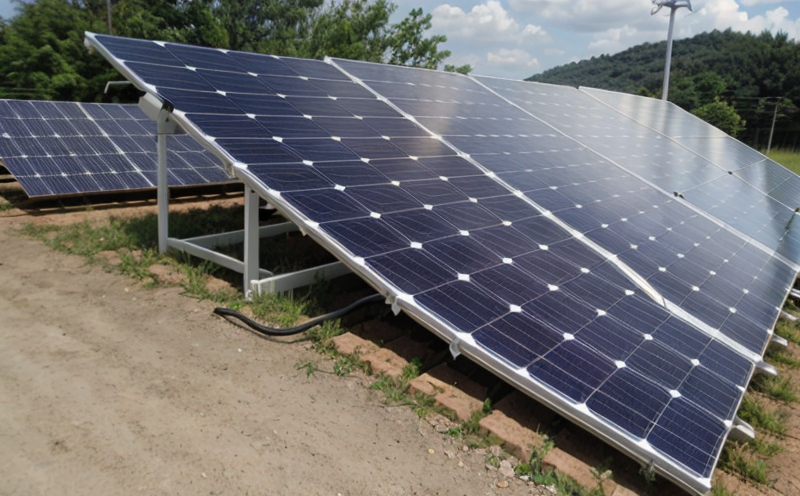IEC 62960 Power Rating Conditions Testing
The IEC (International Electrotechnical Commission) 62960 standard specifies the conditions under which a photovoltaic module's power rating is determined. This testing ensures that solar panels are accurately rated according to their performance in real-world conditions, facilitating reliable comparisons between different products and supporting informed procurement decisions.
Accurate power ratings are crucial for optimizing energy production in solar installations. By ensuring compliance with IEC 62960, manufacturers can demonstrate the true potential of their photovoltaic (PV) modules under defined test conditions. This standard is particularly important given the variability in sunlight exposure and environmental factors that affect PV performance.
For quality managers and R&D engineers, understanding these testing protocols provides a framework for consistent product development and quality assurance. Compliance with IEC 62960 also helps avoid discrepancies between theoretical power ratings and actual output, which is critical for the reliability of solar energy systems.
The testing process involves simulating various environmental conditions to determine how they affect the module's performance. This includes temperature, light intensity, and spectral distribution. The goal is to provide a standardized method that allows for fair comparisons between different PV modules on the market.
Compliance with IEC 62960 ensures that solar panels meet rigorous performance standards set by international authorities. This standardization benefits not only manufacturers but also consumers and installers, as it enhances trust in product quality and performance. For procurement officers, adherence to this standard guarantees consistent supply chain integrity.
The testing process is complex and involves multiple steps. Specimen preparation includes cleaning the PV module surface, calibrating measurement instruments, and ensuring that the module is in a stable state before testing begins. The testing itself consists of exposing the module to specific light conditions while monitoring its output power under defined temperature and humidity levels.
One critical aspect is the use of accurate irradiance meters and thermometers to ensure precise measurements. The standard defines exact procedures for these measurements, including the time required for stabilization after exposure to different light intensities. This ensures that all tests are conducted under controlled conditions, minimizing variability in results.
The acceptance criteria for IEC 62960 are stringent and designed to reflect real-world performance. A module must meet its specified power rating within a narrow tolerance range, typically ±3% of the nominal value. This ensures that the module's actual output closely matches its advertised specifications, providing confidence in its long-term performance.
| Aspect | Description |
|---|---|
| Test Conditions | Temperature, light intensity, spectral distribution are controlled and standardized. |
| Measurement Instruments | Irradiance meters, thermometers, power analyzers are calibrated and used for precise measurement. |
| Data Collection | Continuous monitoring of module performance under defined conditions. |
Why It Matters
The accurate power rating of solar panels is essential for optimizing energy production and ensuring reliable system performance. By adhering to IEC 62960, manufacturers can provide products that meet stringent international standards, enhancing trust among buyers and stakeholders.
Quality managers benefit from this standard as it provides a consistent framework for quality assurance throughout the product lifecycle. Compliance with IEC 62960 also supports R&D efforts by ensuring that new technologies are tested under controlled conditions, leading to more robust designs.
For procurement officers, adherence to this standard ensures a reliable supply chain and reduces the risk of purchasing substandard products. This is particularly important in the renewable energy sector, where system performance directly impacts operational efficiency and financial returns.
Scope and Methodology
| Case | Description |
|---|---|
| Testing Outdoor PV Systems | Evaluating how modules perform under varying environmental conditions. |
| Comparing Module Performance | Standardizing the testing process to ensure fair comparisons between different products. |
The IEC 62960 standard is widely used in the photovoltaic industry for power rating conditions testing. It ensures that PV modules meet international standards, enhancing their reliability and performance under real-world conditions. This standardization benefits manufacturers by providing a consistent framework for quality assurance and R&D, while also supporting procurement officers in making informed decisions.
Use Cases and Application Examples
- Evaluating the efficiency of solar panels under different environmental conditions.
- Comparing the performance of various PV modules to identify the most efficient and reliable options.
- Ensuring compliance with international standards for power rating, enhancing product reliability.
These tests are crucial for optimizing energy production in solar installations. By adhering to IEC 62960, manufacturers can provide products that meet stringent international standards, enhancing trust among buyers and stakeholders.





